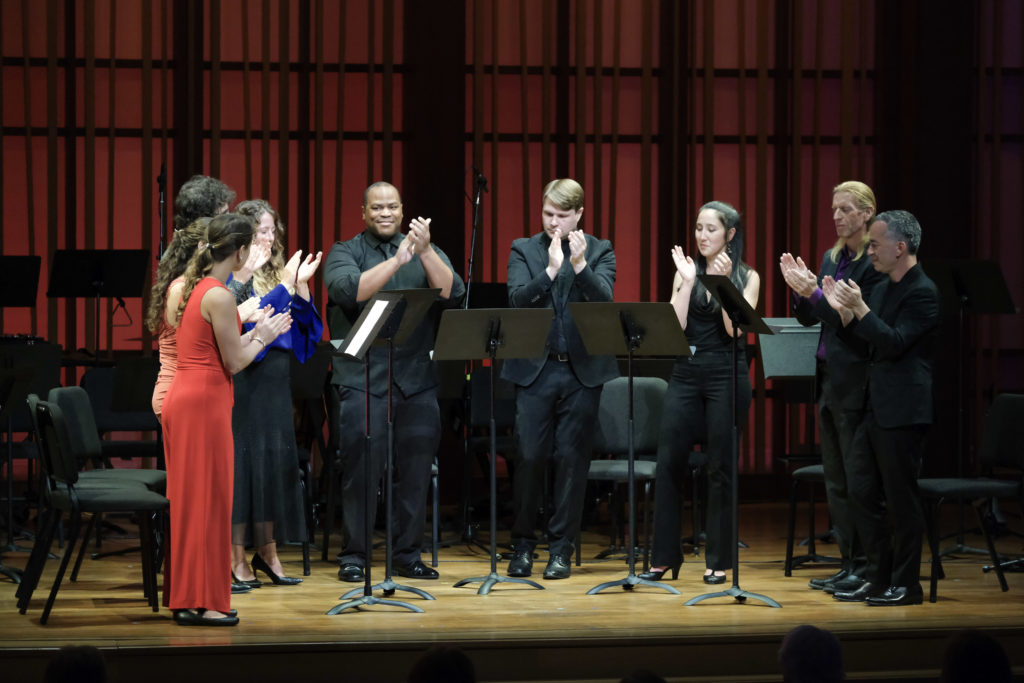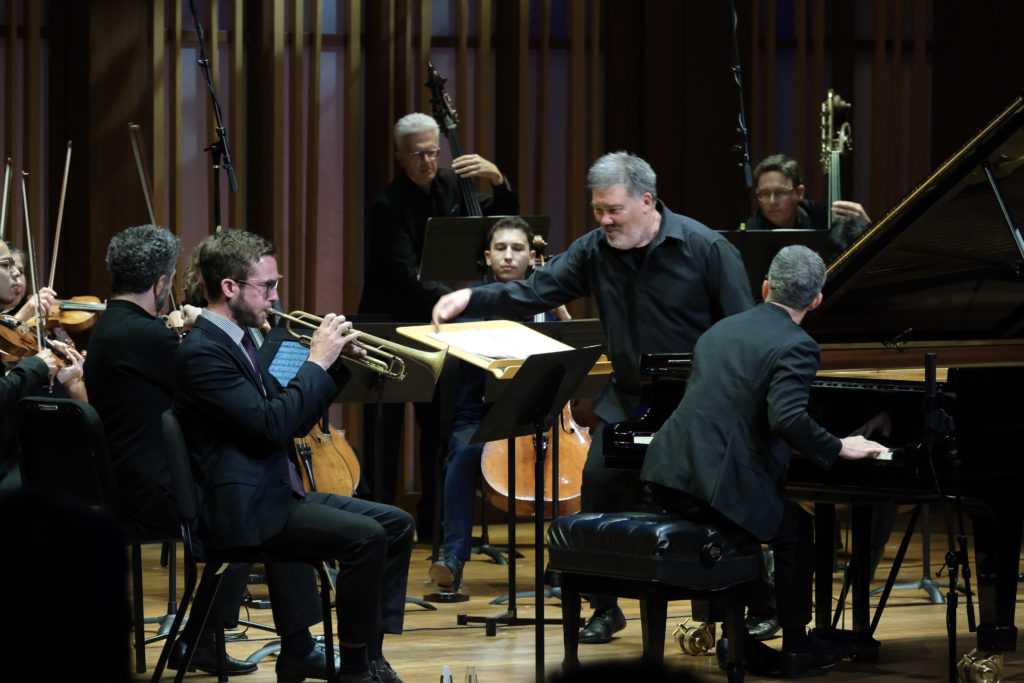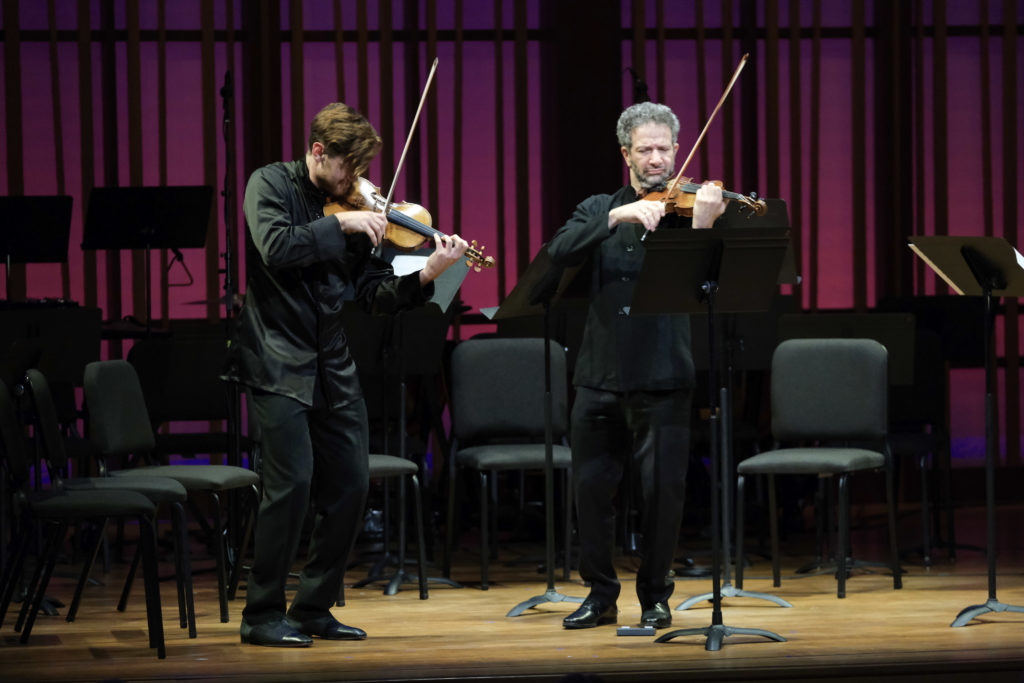La Jolla SummerFest 2023 Opens with a Splendid Cache of Unexpected Music
With the program title Expect the Unexpected, Music Director Inon Barnatan opened La Jolla SummerFest 2023 Friday with a bevy pretty obscure compositions. Even the most devoted concert-goers no doubt encountered Franz Schreker’s 25-minute, single movement Kammersymphonie (Chamber Symphony) for the first time, and both György Ligeti’s Bagatelles for Wind Quintet and Bohuslav Martinu’s piano sextet “La revue de cuisine” are rare offerings.
I doubt Ukrainian composer Dmitri Klebanov is on anyone’s radar—save, perhaps, classical music aficionados of Ukrainian heritage—and certainly the first movement of his String Quartet No. 4 was new to my ears. Although its opening measures quoted literally the opening of the ubiquitous traditional Ukrainian “Bell Carol.”

Sidney Hopson and Justin Donahoe (center) lead SummerFest artists in “Clapping Music” [photo (c.) Ken Jacques]
And Barnatan closed opening night with the too rarely programmed Concerto in C Minor for Piano, Trumpet, and Strings, Op. 35, by Dmitri Shostakovich, performing its dazzling solo piano part with ravishing technical flourish and pellucid insight that was nothing short of breathtaking. Alan Gilbert conducted this striking double concerto with verve and taut precision. It is sometimes called Shostakovich’s Piano Concerto No. 1 because the brilliance of his piano writing tends to overshadow the trumpet part. Happily, trumpeter Brandon Ridenour’s bright but elegantly focused sonority as well as his assertive phrasing suavely complemented Barnatan’s nonpareil performance.

(l. to r.) Brandon Ridenour, trumpet; Alan Gilbert, conductor; Inon Barnatan, piano [photo (c.) Ken Jacques]
Gilbert and the SummerFest Chamber Orchestra gave a rousing account of Schreker’s Chamber Symphony, a work that opens with gentle, languid themes that appear to suggest an Impressionist palette. Sadly, Schreker all too quickly settles into nonstop rhapsodic climaxes that box him into unwavering late Romantic tonality, a style that Erich Korngold also perfected by the 1920s and successfully marketed to Hollywood when he came to the U.S. in the 1930s.
But by 1916, Bartók had already composed his “Allegro barbaro” for solo piano; Stravinsky’s ballet The Rite of Spring had already shocked sophisticated Parisians, and Schoenberg had already composed and staged his shocking monodrama Pierrot Lunaire. These revolutionary works pointed the directions in which 20th-century music was headed, and Schreker’s lush Chamber Symphony was intently staring in the opposite direction.
The Czech composer Bohuslav Martinu certainly knew how to integrate the latest trends into his strict classical training. The 1920s were still roaring in 1927 when he completed his jazz-influenced ballet “La revue de cuisine” for clarinet, clarinet, trumpet, bassoon, violin, cello and piano. From this ballet he extracted a four-movement suite that cleverly exalts the tango and Charleston in a similar way that J.S. Bach elevated Gavottes and Allemandes in his many dance suites. Kudos to trumpet virtuoso Ridenour for his classy jazz riffs throughout this suite, and to bassoonist Eleni Katz and cellist Oliver Herbert for their intricate but winning thematic duels in the Charleston movement.
Everyone knows John Philip Sousa’s march “The Stars and Stripes Forever,” but only devoted violinists know Bruce Dukov’s arrangement of the march for two violinists written as if it were a Paganini Caprice. To be sure, violinists Blake Pouliot and Steven Copes sailed through this arrangement’s astonishing pyrotechnics with enviable facility, and the opening night audience roared its approval. But . . . a piece such as this is dangerously close to a stunt.An offstage brass quintet opened the concert with an “Intrada” by Thomas Simpson and a “Canzona” by Bastian Chilese, appropriately festive music by obscure but masterful 17th-century European composers.
This concert was presented by the La Jolla Music Society on July 28, 2023, at La Jolla’s Conrad Prebys Performing Arts Center.

Ken Herman, a classically trained pianist and organist, has covered music for the San Diego Union, the Los Angeles Times’ San Diego Edition, and for sandiego.com. He has won numerous awards, including first place for Live Performance and Opera Reviews in the 2017, the 2018, and the 2019 Excellence in Journalism Awards competition held by the San Diego Press Club. A Chicago native, he came to San Diego to pursue a graduate degree and stayed.Read more…

